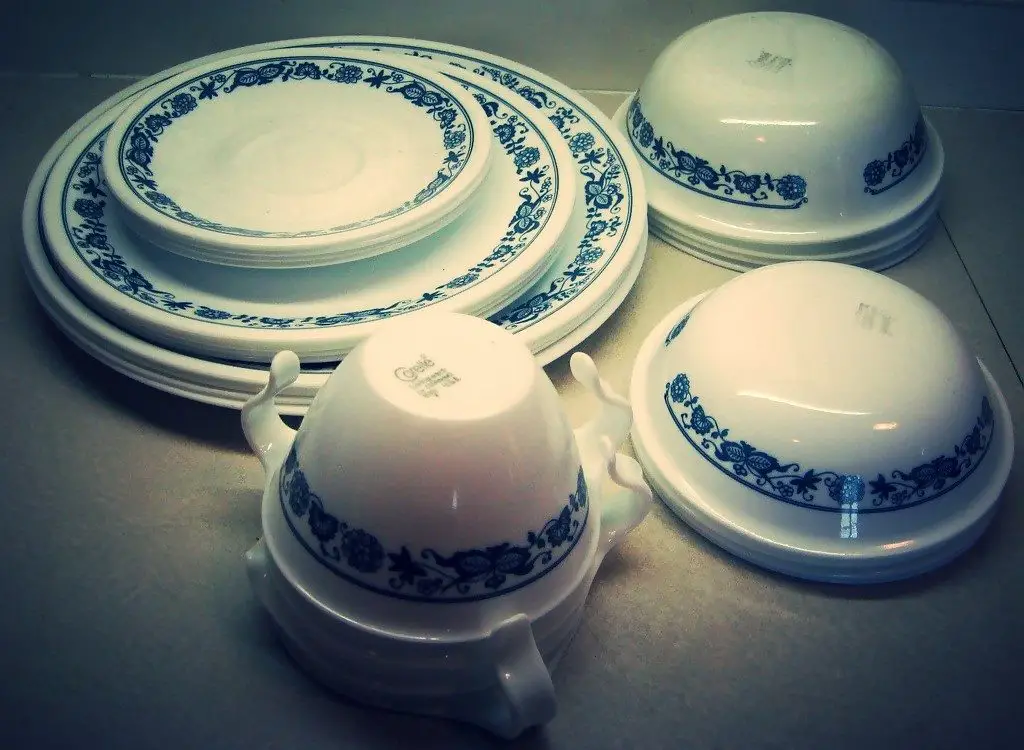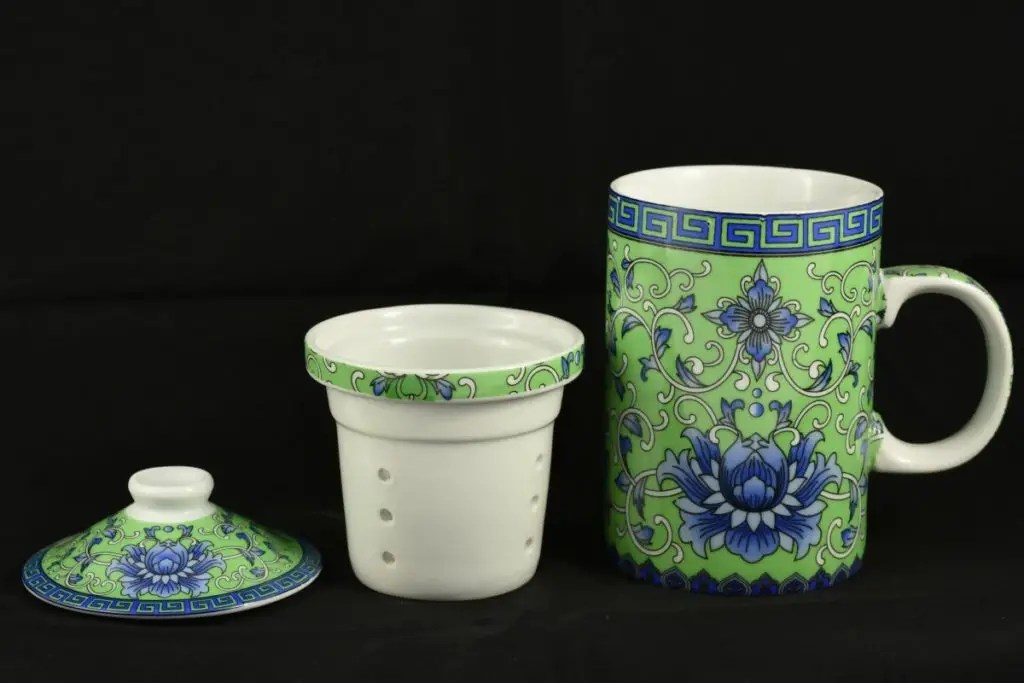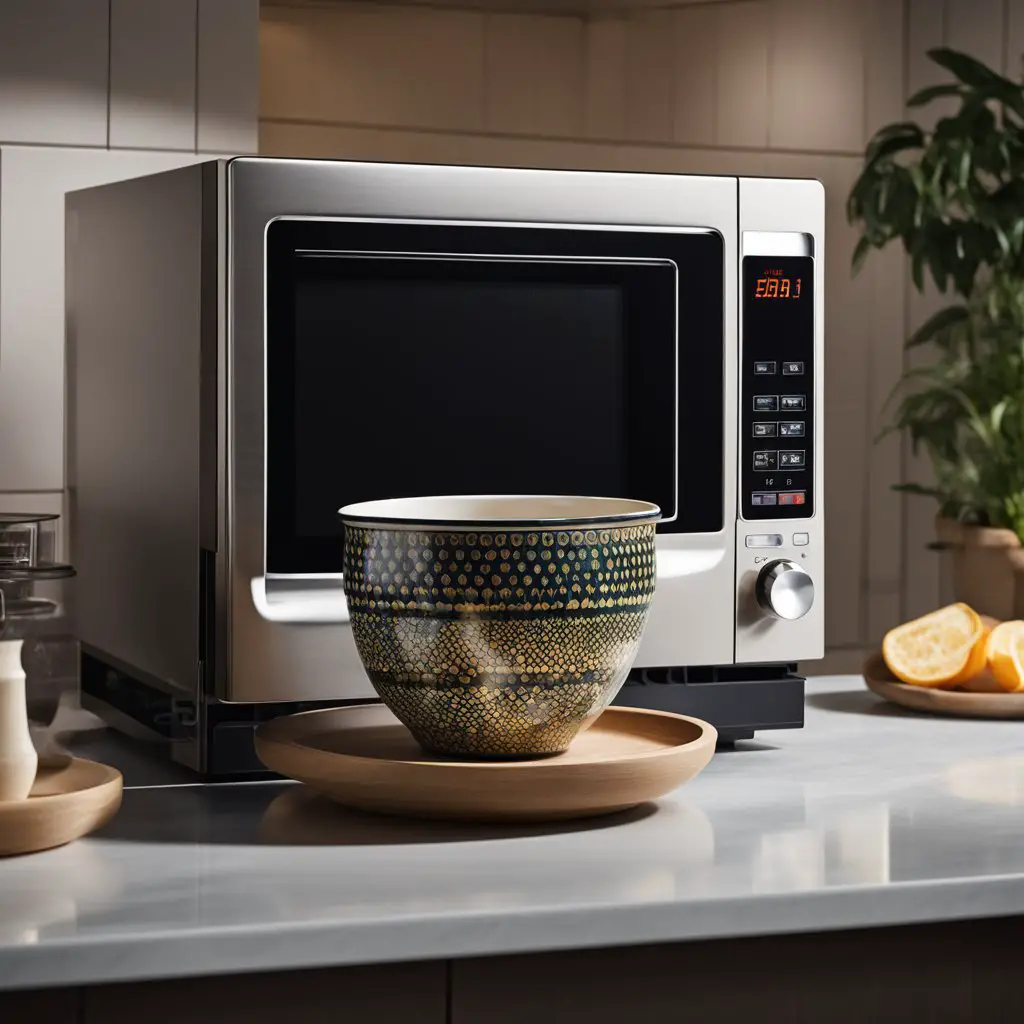When you make a pottery piece, chances are if you plan on making this food-safe, you will throw it in the microwave. But, is pottery always microwave-safe?

The answer is no, not all pottery is the same.
But, in this, we’ll answer the question of whether can pottery goes in the microwave, the truth about throwing it in there, and what it means for you as a potter.
Not every Pottery Piece is the Same
That should be a given, but not every pottery piece is the same.
There are a few factors that can affect whether you can throw it in the microwave or not, and they include the following:
- Glaze type
- Slip type
- Whether it was fired or not
There are a few glaze types that shouldn’t be thrown in the microwave for various reasons. They include the following:
- Any ceramics decorated with gold
- Any ceramics with silver in them
- Any ceramics that have precious metal in them
Metal should never be used in the microwave, but there are a few other factors to consider as well.

Remember, not every ceramic is the same, and some of them are fired to higher temperatures and are non-porous. Those usually are safe for the microwave.
These include the following:
- Stoneware
- Bone china
- Porcelain
- Vitreous cookware
These are all microwave-safe, and there are a few reasons for this, you should always definitely take time to figure out whether or not they’re safe.
Heating Concerns
One of the biggest concerns with pottery, especially in microwaves is heating. That is because not all microwaves evenly hat everything.
Have you ever put something in the microwave, only for it to come out and half of it isn’t even heated up? That’s an example of uneven heating.
In general, you should always consider the following when you’re heating pottery since it can be affected by the heat of a microwave:
- Sometimes if they’re heated unevenly, they can crack
- There may be extra stress concerns to take into consideration
- Never have the pottery go from a suddenly high heat to a colder heat
- Make sure that the pottery that’s put in there will not melt due to the temperatures
- Don’t try to subject it to too many shocks
For many potters, they may not realize that there are a lot of stressors when you throw them in the microwave, and in the next section we’ll go over those stressors, and why you should be careful with them too.
The Stressors Microwaves Provide
Microwaves are great for heating food, but they can be incredibly stressful on pottery.
You should make sure you understand a few considerations when you put pottery in the microwave. that’s because microwaves contain the following:
- A high-heat experience incredibly quickly
- Radiation and other waves
- Uneven heating in some cases
- If left for a long time, the high heat can crack the pottery
That is why, if you plan to heat your pottery up in the microwave, you should always make sure that you don’t put anything in there for too long and always make sure that you have the pottery half full of whatever you’re trying to cook before you can throw it in the microwave.
Why should you never throw this type of pottery without food in the microwave though? Well, it can cause the following to happen:
- The pottery can get pressured
- It can crack
- There is a chance that parts of it will break, but not the whole thing
If you’re someone who likes to cook items in the microwave, always make sure that you understand this, since it can play a major part in the way that your pottery turns out. You don’t want to have to worry about your potter breaking, reducing all of your hard work to nothing, right?
What About unfired Pottery?
This is a big no-no. Never put unfired pottery in the microwave.
Why is that? Well for one, they’re incredibly poisonous in that stage when it comes to investing, but here are a couple of other reasons why you should never put unfired pottery in the microwave.
- They can melt
- They can crack
- Oftentimes, if you’re not careful it can be destroyed
- The clay contaminants will be present in the foods
- You could be ingesting silica, which is incredibly toxic
The reason for firing pottery is to help turn these chemicals into something else. When you have quartz inversion and other aspects of the process, it helps create a barrier and takes out all of the contaminants so that it doesn’t get into the food.
When you fire anything that is unfired, it will inevitably contain a lot of problems and contaminants that aren’t safe for human consumption. Simply put, you’re putting yourself in danger with everything that’s happening.
If you’re worried about whether or not you should use this in the microwave, then you’re better off getting another dish that microwave-safe. don’t put yourself in danger when it comes to this type of cooking.
What about Frozen Food?
Some people think pottery can handle frozen foods well, and typically that’s because of the following:
- They’ve already been fired high
- Because of that, they can handle the temperatures, right?
- They often believe that frozen foods won’t be affected by this
But, here’s the thing, potter doesn’t do well with frozen foods. There are a few obvious reasons for that, and they include the following:
- Frozen foods need to be heated up for a long time
- They need to be heated up high
This, in turn, runs the risk of breaking, which is a big problem. Think about it, if you’re going to throw something in the microwave for twenty minutes on high, it needs to have the ability to not break.
Frozen foods are not good for microwaves as well. They take forever, and often, it’s best if you use other means.
So what is the best way to heat up frozen foods then? Well, consider the following:
- Get dishes that are safe for prolonged high temperatures
- If nothing else, throw it in the oven, or boil it to thaw
- If you can, leave it out to thaw for a minute before you throw it in the microwave
- Try to get the piece to above freezing before you throw it in there
Frozen foods don’t mix very well with pottery, and often, this will ruin your own experience with it, so make sure that you don’t use this, especially if you’re trying to keep your pottery safe.
The Safety Concerns for Pottery Products

When it comes to pottery products there are a few concerns that come with using pottery in the microwave, and before you even think about throwing these in the microwave, you should think about the following:
- Whether or not they are bone dry
- Are they not absorbing water
If you notice that they aren’t bone dry, or fully ceramic, or if you notice that they are absorbing water, you need to not use these.
A lot of times, people think that any old pottery can go into the oven. However, you shouldn’t throw earthenware into there.
That is because of the following:
- They often aren’t glazed
- They don’t fully absorb the water
- They are incredibly porous, so they end up soaking up a lot of the water and other contaminants
- You may not have something that is bone-dry
If you feel a bit unsure of whether or not you should use this in the microwave, then don’t use it. You are better off no using something that is harmful to you in the microwave.
Look to see if it’s a microwave-safe
Let’s take a moment to talk about “microwave-safe” items. However, here’s the problem with them.
They tend to not be completely microwave-safe. A lot of companies add this because of the following:
- They may not completely keep the contaminants out
- They tend to break down over time
If it’s from a brand you don’t trust, don’t ever put it in the microwave. If you use a glaze that doesn’t say it’s microwave-safe, then never put it in the microwave.
Lots of times, people think that all types of materials are microwave-safe, but in general, you should only use the following in the microwave:
- Ceramic containers
- Glass containers
What determines whether or not your cookware is microwave safe is essential whether or not it can handle all of this. It’s more than just the temperature though, you need to make sure that you’re not harming your foods with this.
When you use items that aren’t microwave-safe in the microwave, the following can happen:
- The molecules in the food can vibrate
- The molecules in the water can vibrate
- This jostles other molecules, and that can create lots of heat
- It heats your pottery, potentially compromising it
- But that’s not all, it can potentially be trapped, and then, later on, explode in some cases
- It can even make sparks fly in some instances
Remember that the food will heat the containers up, or whatever you’re throwing in there. This is very important to make sure that you understand since this can potentially hurt your pottery.
If you understand that, you’ll be able to prevent it.
What about pottery that isn’t microwave-safe, or the glaze isn’t microwave-safe? What happens then?
Well, if you do that, it can cause the following:
- Small bubbles can form
- You can have a bubbling glaze
- It can then potentially explode
So either way, it’s not good for you to have, and it’s best if you just make sure that you don’t have this happen to your pottery, and make sure that it’s safe.
How to Prevent This
The best way to prevent it is to be proactive regarding this and understand what it is that’s happening with your pottery.
Essentially, that means that you need to do the following:
- Always make sure that your pottery is heated high enough that it won’t break
- Make sure any glazes that are used are microwave-safe
- Always make sure that you’re only using appropriate pottery materials in the microwave
- If you’re in doubt, don’t throw it in the microwave
- If it’s pottery that you’ve bought from a company or someone else, always research to ensure that you’re not potentially hurting yourself
- When putting pottery in the microwave the first time, watch it
- Don’t put frozen foods in pottery containers
- Never heat pottery for super long periods
These are all important safety factors that you should know, and you should have a good idea of what it is that you need to do to prevent the worst from happening. Remember that your pottery is very important to understand, and you need to ensure that you’re giving yourself the best results possible with this, and make sure that you’re providing a safe experience.
Pottery can go in the microwave, but you need to understand that not all pottery is equal.
The Answer
The answer is simply yes, it can, but you always need to take a few considerations into mind. There are a few things that are better off not being anywhere near the microwave and a few things that are fine to microwave.
With pottery, the general rule of thumb though, is that if it’s not glazed, don’t put yourself in danger by putting it in the microwave. This can, in turn, create a disaster for you.
Hopefully, this answers the question and can help you figure out what to do with the next piece.







